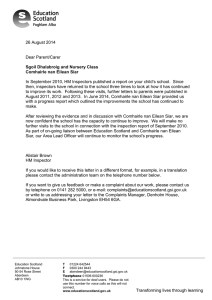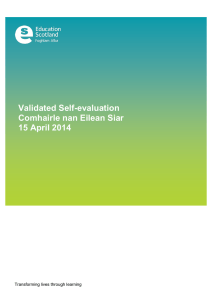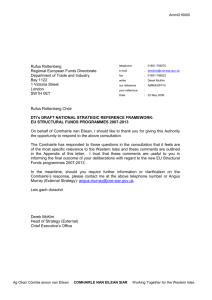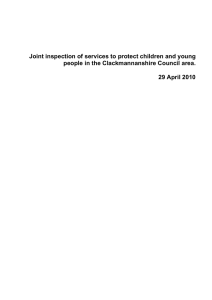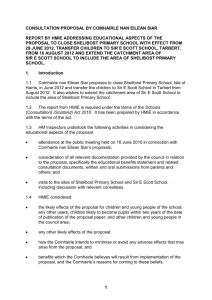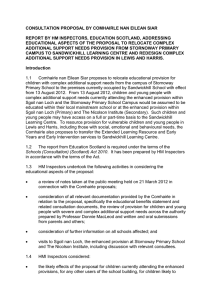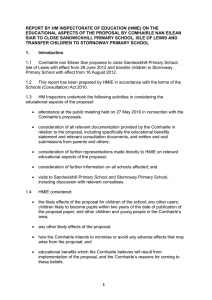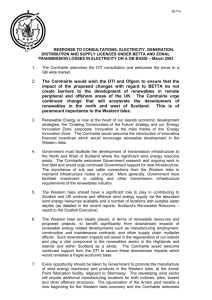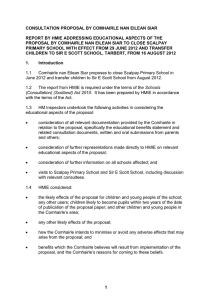Joint inspection of services to protect children and young
advertisement
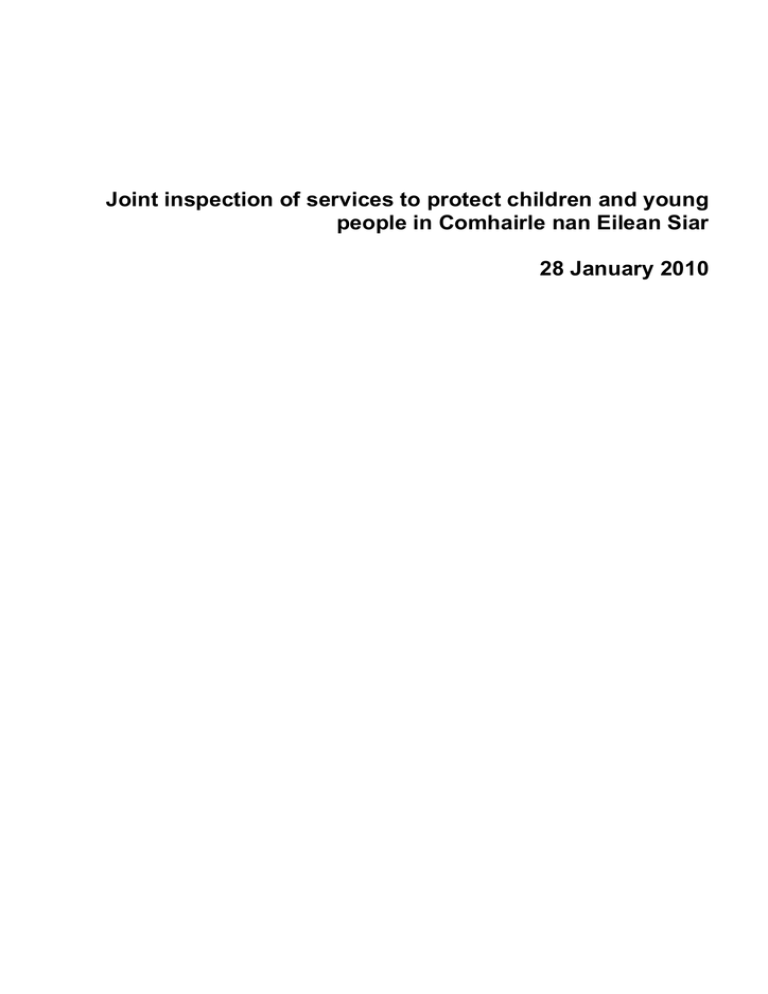
Joint inspection of services to protect children and young people in Comhairle nan Eilean Siar 28 January 2010 The inspection of services to protect children1 in Comhairle nan Eilean Siar was carried out in October and November 2009. We looked at the services provided by health, the police, the council and the Children’s Reporter. We also looked at the services provided by voluntary and independent organisations. Our report describes how good they are at protecting children and keeping them safe. To find this out we read a sample of children’s files which were held by these services. We talked to a number of children and their parents and carers to listen to their views about the services they had received. We also spoke to staff in these services who worked with children, parents and carers and to senior managers who were responsible for these staff and the services they provided. What we found and tell you about in this report is based on a sample of children and families. We cannot promise that this will be the same for every child in the area who might need help. A team of inspectors gathered all the information and helped to write this report. These inspectors have experience of working across the range of services involved in protecting children. Inspection teams include professional staff who work in other council areas in Scotland. 1 When we refer to children in this report we mean children and young people under the age of 18 years. Contents 1. The area 2. Particular strengths that make a difference to children and families 3. Examples of good practice 4. How well are the needs of children and families met? 5. How good is the management and delivery of services? 6. How good is leadership and direction? 7. How are services improving? 8. What happens next? 1. The Area 2. Comhairle nan Eilean Siar is a chain of islands lying to the north west of Scotland. The population is around 26,000. with 20% under 18 years, this is about the same as the Scottish average. Most of the population live on the Isle of Lewis, with around 12,000 living in the Stornoway area. The number of children referred to the council for child protection enquiries decreased between 2006 and 2008. The level of referrals is less than Scotland as a whole. The proportion of children on the Child Protection Register (CPR) in Comhairle nan Eilean Siar is 5.1 per 1000, which is higher than the national average of 2.9 per 1,000.2 2 Care must be taken with interpreting this figure as it will be affected by the comparatively small population of children aged under 15 in the Comhairle nan Eilean Siar. 1 2. Particular strengths that make a difference to children and families • Services working well together to help keep children safe, especially in the early years. • The prompt response by staff, volunteers and communities to child protection concerns. • Not having to travel out of local communities (including rural areas) to access services to help keep children safe. 3. Examples of good practice • The early years and early intervention strategy which is helping young families become less isolated and stressed. • The Stornoway Contact Centre which is helping looked after children have safe and enjoyable contact with members of their families on a regular basis. • POINTERS young mums’ group which is supporting young parents to be more confident and positive about their futures. 4. How well are the needs of children and families met? Children are aware of their right to be safe. They know who to contact if they need help or feel worried. They receive sound advice at school about keeping safe when using mobile phones and the internet, 2 including social networking sites. Families benefit from a wide range of well coordinated support including that from Action for Children, through and after care and Sure Start. Support services are carefully tailored to meet the needs of individual families. Parenting programmes help parents to be more confident about caring for their children and keeping them safe. Teen support gives sound advice on how to keep safe to those children living in a family affected by domestic abuse. Some families facing the effects of domestic abuse are not benefitting fully or early enough from the range of services available. Staff are very alert to circumstances where children may be at risk. When children or members of the public contact them with concerns, they treat these seriously and act quickly. Interviews carried out jointly between police and social workers are very well-planned and take place in child-friendly rooms. Police officers and social workers usually explain very carefully to children and their families the actions they are taking and the reasons for these. Children and parents involved in child protection investigations would benefit from clear written information to help them understand what to expect and where to go for more advice. Staff and members of the community work very well together to make sure that children at immediate risk are kept safe. Legal measures to keep children safe are used whenever they are needed. When it is not safe for children to remain at home, they are placed with relatives or foster carers. Checks are usually made to make sure that these placements are suitable. Overall, services have a positive impact on children in need of protection. There are helpful approaches to planning for and meeting their short and medium term needs. Children benefit from a wide range of therapy and specialist services locally, even when they don’t live near a town or health centre. There has been an increase in services available for families living in the Uists and Barra. Child and adolescent mental health staff take the lead in providing a range of beneficial support to improve children’s mental health and well-being. 3 Services for some children do not continue for long enough after their names are removed from the Child Protection Register. There are some delays in carrying out assessments of the suitability of kinship carers to meet children’s needs in the long term. A few kinship carers require higher levels of support. Some children who need permanent placements with new families are experiencing lengthy delays. Police officers and social work staff are effective in making sure children are safe if they run away from home. Education staff work hard to ensure that they alert parents without delay if children are absent from school. A thoughtful policy and appropriate systems are in place to track and trace those who go missing from education. Members of the Child Protection Committee (CPC) have given careful thought to how to help and support children who may have been brought into or moved around the country illegally and are at risk of harm. They are preparing appropriate procedures and have arranged training to raise awareness among staff. Staff awareness of the worries faced by young people who are unsure of their sexual identity has been raised through well-targeted training. Overall, children are benefiting from effective communication and trusting relationships with staff who know them well and listen to their views. Parents attending child protection meetings usually have their views taken into account. Children involved with the children’s hearing system benefit from very supportive communication with the Children’s Reporter and panel members. Some children involved in child protection processes need to be given more help to make sure that their own views are heard separately from their parents. Some children need to see their social worker more often so that they can form a trusting relationship. 4 5. How good is the management and delivery of services? Managers across services are committed to continue improving the quality of their work to protect children. They work well together to take a close look at their services and are carefully planning further improvements. They are making good progress in involving greater numbers of staff in looking closely at their own work to see how they can improve children’s lives. A very effective and well-planned training programme to improve staff skills in child protection has been put in place. All services have played a strong part in planning for joined-up children’s services. They are working hard to make sure that important decisions are made at a local level. Local people, including children and families, have yet to become fully involved in this approach. Decisions about medical examinations for children in need of protection are taken jointly by health, police and social work staff. Children requiring a medical examination are seen by appropriately experienced doctors. Arrangements to involve health staff in discussions need to be strengthened to ensure that children’s health needs are not overlooked. Staff work together to share information about sex offenders who may be a risk to children. Services have worked well together to produce helpful documents to guide staff in their work to help keep children safe. These include shared arrangements for ensuring that children affected by substance misuse are properly protected and that children have their sexual health needs met well. Managers now need to ensure that all staff are supported to put this guidance into practice. There is a need for managers to put plans in place without delay to improve the quality of the management, recording and reviewing of information to help children who may be at risk. This includes giving guidance to staff on the use of dated lists of significant events in a child’s life. Some children are waiting too long for important decisions to be made as a result of delays in social work reports going to the Children’s Reporter. 5 6. How good is leadership and direction? The Chief Officers and the CPC are very visible leaders who make sure that child protection is a high priority in all services. They have formed strong relationships and worked well as a team to agree a shared aim to keep children safe. Their sense of common purpose and knowledge of national guidance shape the work of their services. They jointly promote positive attitudes to diversity and make sure that staff are given suitable written advice to support this. Commendably, they are making sure that children and families receive an appropriate level of service no matter which part of the council area they live in. The CPC chair leads very effectively and works well with senior managers to make improvements to services to protect children. Voluntary organisations are fully involved in planning services and many of the projects and services which help to keep children safe are run by them. 7. How are services improving? Senior managers are working well together to join up children’s services to make children’s lives better. They are updating their Integrated Children’s Services Plan with clear aims for the children of Comhairle nan Eilean Siar, including keeping them safe. Staff and children are beginning to be more involved in planning children’s services, but this is at an early stage. Service managers are making sound progress in ensuring that joint self-evaluation of their services continues to improve and is routinely built into their activities. Self-evaluation has helped them to identify strengths in their services as well as areas for further development. A number of important changes and improvements have been introduced as a result of services looking closely at their work and deciding what needs to be done better. These changes include taking positive action to improve services giving advice to young people on sexual health and a stronger emphasis on effective working in children’s early years. The work of the Stornoway Contact Centre is 6 improving the experiences of looked after children in maintaining positive relationships with members of their families. Following the most recent child protection inspection, a number of areas for improvement were agreed and members of the CPC have developed a Joint Agency Action Plan to work on these. Staff are making steady progress in number of these areas, including becoming better at self-evaluation and developing guidance for staff working with children affected by drugs or alcohol. Progress with improving arrangements to make sure that decisions about children are clearly recorded has been slower. 8. What happens next? We are confident that services will be able to make the necessary improvements in light of the inspection findings. As a result, we will make no more visits in connection with this inspection. Our link inspector will maintain contact with services to support improvements. We have agreed the following areas for improvement with services in Comhairle nan Eilean Siar. • Increase the effectiveness of approaches to meeting the needs of children affected by domestic abuse. • Ensure that information and decisions about children in need of protection are systematically recorded, reviewed and analysed to help reduce risk. • Strengthen arrangements to ensure the longer term needs of children are met. 7 Quality indicators help services and inspectors to judge what is good and what needs to be improved in the work to protect children and meet their needs. You can find these quality indicators in the HMIE publication How well do we protect children and meet their needs? Following the inspection of each local authority area, the Scottish Government gathers evaluations of four important quality indicators to keep track of how well services across Scotland are doing to protect children and meet their needs. Here are the evaluations for these in Comhairle nan Eilean Siar. Children are listened to and respected Children are helped to keep safe Response to immediate concerns Meeting needs and reducing long term harm good good very Good satisfactory We also evaluated the following aspects of the work within the local authority area. Self-evaluation Improvements in performance good good Clare Lamont HM Inspector February 2010 8 To find out more about inspections or get an electronic copy of this report go to www.hmie.gov.uk. Please contact the Business Management and Communications Team (BMCT) if you wish to enquire about our arrangements for translated or other appropriate versions. If you wish to comment about any of our inspections, contact us at HMIEenquiries@hmie.gsi.gov.uk or alternatively you should write in the first instance to BMCT, HM Inspectorate of Education, Denholm House, Almondvale Business Park, Almondvale Way, Livingston EH54 6GA. Our complaints procedure is available from our website www.hmie.gov.uk or alternatively you can write to our Complaints Manager, at the address above or by telephoning 01506 600259. If you are not satisfied with the action we have taken at the end of our complaints procedure, you can raise your complaint with the Scottish Public Services Ombudsman (SPSO). The SPSO is fully independent and has powers to investigate complaints about Government departments and agencies. You should write to SPSO, Freepost EH641, Edinburgh EH3 0BR. You can also telephone 0800 377 7330, fax 0800 377 7331 or e-mail: ask@spso.org.uk. More information about the Ombudsman’s office can be obtained from the website at www.spso.org.uk. This report uses the following word scale to make clear judgements made by inspectors. excellent very good good satisfactory weak unsatisfactory outstanding, sector leading major strengths important strengths with some areas for improvement strengths just outweigh weaknesses important weaknesses major weaknesses Crown Copyright 2010 HM Inspectorate of Education
